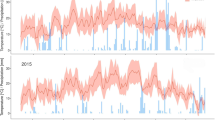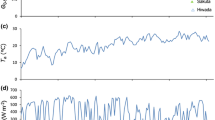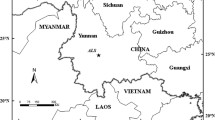Abstract
Bamboo forests have been expanding rapidly in Asian countries for the past 50 years. Whether natural or artificial, this expansion involves the replacement of other vegetation types by bamboo, which could impact the local water cycle. Previous studies in Japan have reported that bamboo forests have higher transpiration than coniferous forests under temperate climates, but it is unknown whether this finding applies to subtropical climates. Thus, we examined whether a Moso bamboo (Phyllostachys pubescens) forest exhibits higher transpiration in a subtropical climate. We used the sap-flux method to estimate the stand transpiration (E) of Moso bamboo and Japanese cedar (Cryptomeria japonica) forests in Taiwan. As was observed in the Japanese studies, annual E for bamboo (478 mm) was higher than that for cedar (122 mm), although we found a difference in the seasonality of E between the Taiwanese and Japanese sites. Canopy conductance (Gc) for bamboo was higher than that for cedar in Taiwan, which was reported previously for Japan. Gc for bamboo in Taiwan was comparable to that in Japan, despite a difference in the leaf area index (LAI). Gc for cedar in Taiwan was lower than that in Japan. This difference in Gc between Taiwan and Japan corresponded to differences in the sapwood area and LAI. These findings suggest a significant change in E and, therefore, the terrestrial water and carbon cycle, regardless of different climates, when Japanese cedar forests are replaced by Moso bamboo forests.






Similar content being viewed by others
References
Chen X, Zhang X, Zhang Y, Booth T, He X (2009) Changes of carbon stocks in bamboo stands in China during 100 years. For Ecol Manag 258:1489–1496. doi:10.1016/j.foreco.2009.06.051
Chiu CW, Komatsu H, Katayama A, Otsuki K (2016) Scaling-up from tree to stand transpiration for a warm-temperate multi-specific broadleaved forest with a wide variation in stem diameter. J For Res 21:161–169. doi:10.1007/s10310-016-0532-7
Collatz GJ, Ball JT, Grivet C, Berry JA (1991) Physiological and environmental regulation of stomatal conductance, photosynthesis and transpiration: a model that includes a laminar boundary layer. Agric For Meteorol 54:107–136. doi:10.1016/0168-1923(91)90002-8
Dierick D, Hölscher D, Schwendenmann L (2010) Water use characteristics of a bamboo species (Bambusa blumeana) in the Philippines. Agric For Meteorol 150:1568–1578. doi:10.1016/j.agrformet.2010.08.006
Escalona JM, Bota J, Medrano H (2015) Distribution of leaf photosynthesis and transpiration within grapevine canopies under different drought conditions. VITIS J Grapevine Res 42:57
Forestry Bureau of Taiwan (2015) http://www.forest.gov.tw/0002393
Forrester DI (2015) Transpiration and water-use efficiency in mixed-species forests versus monocultures: effects of tree size, stand density and season. Tree Physiol 35:289–304. doi:10.1093/treephys/tpv011
Granier A (1985) Une nouvelle méthode pour la mesure du flux de sève brute dans le tronc des arbres. Ann Sci For 42:81–88 (French)
Granier A, Biron P, Lemoine D (2000) Water balance, transpiration and canopy conductance in two beech stands. Agric For Meteorol 100:291–308. doi:10.1016/S0168-1923(99)00151-3
Helman D, Osem Y, Yakir D, Lensky IM (2017) Relationships between climate, topography, water use and productivity in two key Mediterranean forest types with different water-use strategies. Agric For Meteorol 232:319–330. doi:10.1016/j.agrformet.2016.08.018
Hsieh IF, Kume T, Lin MY, Cheng CH, Miki T (2016) Characteristics of soil CO2 efflux under an invasive species, Moso bamboo, in forests of central Taiwan. Trees 30:1749–1759. doi:10.1007/s00468-016-1405-6
Ichihashi R, Komatsu H, Kume T, Onozawa Y, Shinohara Y, Tsuruta K, Otsuki K (2015) Stand-scale transpiration of two Moso bamboo stands with different culm densities. Ecohydrology 8:450–459. doi:10.1002/eco.1515
Isagi Y, Torii A (1997) Range expansion and its mechanism in a naturalized bamboo species, Phyllostachys pubescens, in Japan. J Sustain For 6:127–142. doi:10.1300/J091v06n01_08
James SA, Clearwater MJ, Meinzer FC, Goldstein G (2002) Heat dissipation sensors of variable length for the measurement of sap flow in trees with deep sapwood. Tree Physiol 22:277–284
Karlberg L, Ben-Gal A, Jansson PE, Shani U (2006) Modelling transpiration and growth in salinity-stressed tomato under different climatic conditions. Ecol Model 190:15–40. doi:10.1016/j.ecolmodel.2005.04.015
Komatsu H, Onozawa Y, Kume T, Tsuruta K, Kumagai TO, Shinohara Y, Otsuki K (2010) Stand-scale transpiration estimates in a Moso bamboo forest: II. Comparison with coniferous forests. For Ecol Manag 260:1295–1302. doi:10.1016/j.foreco.2010.06.040
Komatsu H, Onozawa Y, Kume T, Tsuruta K, Shinohara Y, Otsuki K (2012) Canopy conductance for a Moso bamboo (Phyllostachys pubescens) forest in western Japan. Agric For Meteorol 156:111–120. doi:10.1016/j.agrformet.2012.01.004
Komatsu H, Shinohara Y, Kumagai TO, Kume T, Tsuruta K, Xiang Y, Nogata M, Ichihashi R, Tateishi M, Shimizu T, Miyazawa Y, Laplace S, Han T, Chiu CW, Ogura A, Saito T, Otsuki K (2014) A model relating transpiration for Japanese cedar and cypress plantations with stand structure. For Ecol Manag 334:301–312. doi:10.1016/j.foreco.2014.08.041
Kuehl Y, Li Y, Henley G (2013) Impacts of selective harvest on the carbon sequestration potential in Moso bamboo (Phyllostachys pubescens) plantations. For Trees Livelihoods 22:1–18. doi:10.1080/14728028.2013.773652
Kumagai TO, Tateishi M, Shimizu T, Otsuki K (2008) Transpiration and canopy conductance at two slope positions in a Japanese cedar forest watershed. Agric For Meteorol 148:1444–1455. doi:10.1016/j.agrformet.2008.04.010
Kume T, Onozawa Y, Komatsu H, Tsuruta K, Shinohara Y, Umebayashi T, Otsuki K (2010) Stand-scale transpiration estimates in a Moso bamboo forest: (I) applicability of sap flux measurements. For Ecol Manag 260:1287–1294. doi:10.1016/j.foreco.2010.07.012
Li R, Werger MJA, During HJ, Zhong ZC (1998) Biennial variation in production of new shoots in groves of the giant bamboo Phyllostachys pubescens in Sichuan, China. Plant Ecol 135:103–112. doi:10.1023/A:1009761428401
Lin MY, Hsieh IF, Lin PH, Laplace S, Ohashi M, Chen TH, Kume K (2017) Moso bamboo (Phyllostachys pubescens) forests as a significant carbon sink? A case study based on 4-year measurements in central Taiwan. Ecol Res. doi:10.1007/s11284-017-1497-5
McNaughton KG, Black TA (1973) A study of evapotranspiration from a Douglas fir forest using the energy balance approach. Water Resour Res 9:1579–1590. doi:10.1029/WR009i006p01579
Mei T, Fang D, Röll A, Niu F (2016) Water use patterns of four tropical bamboo species assessed with sap flux measurements. Front Plant Sci 6:1202. doi:10.3389/fpls.2015.01202
Pataki DE, Oren R (2003) Species differences in stomatal control of water loss at the canopy scale in a mature bottomland deciduous forest. Adv Water Resour 26:1267–1278. doi:10.1016/j.advwatres.2003.08.001
Ruiz P, Belcher M, Fu B, Yang X (2003) Forestry, poverty, and rural development: perspectives from the bamboo subsector. In: Hyde WF, Jintao X, Belcher B (eds) China’s forests: global lessons from market reforms: 151–176. Resources for the Future and CIFOR, Washington
Running SW (1984) Microclimate control of forest productivity: analysis by computer simulation of annual photosynthesis/transpiration balance in different environments. Agric For Meteorol 32:267–288. doi:10.1016/0168-1923(84)90054-6
Running SW, Coughlan JC (1988) A general model of forest ecosystem processes for regional applications I. Hydrologic balance, canopy gas exchange and primary production processes. Ecol Model 42:125–154. doi:10.1016/0304-3800(88)90112-3
Shinohara Y, Otsuki K (2015) Comparisons of soil–water content between a Moso bamboo (Phyllostachys pubescens) forest and an evergreen broadleaved forest in western Japan. Plant Species Biol 30:96–103. doi:10.1111/1442-1984.12076
Song X, Zhou G, Jiang H, Yu S, Fu J, Li W, Wang W, Ma Z, Peng C (2011) Carbon sequestration by Chinese bamboo forests and their ecological benefits: assessment of potential, problems, and future challenges. Environ Rev 19:418–428. doi:10.1139/a11-015
Tseng H, Chiu CW, Laplace S, Kume T (2017) Can we assume insignificant temporal changes in spatial variations of sap flux for year-round individual tree transpiration estimates? A case study on Cryptomeria japonica in central Taiwan. Trees. 1–13. doi: 10.1007/s00468-017-1542-6
Tu TC, Wang YN, Shiau EL (2003) Efficiency of carbon dioxide fixation by Phyllostachys pubescens. J Exp For Nat Taiwan Univ 17:187–194 (In Chinese)
Wilson KB, Hanson PJ, Mulholland PJ, Baldocchi DD, Wullschleger SD (2001) A comparison of methods for determining forest evapotranspiration and its components: sap-flow, soil water budget, eddy covariance and catchment water balance. Agric For Meteorol 106:153–168. doi:10.1016/S0168-1923(00)00199-4
Wullschleger SD, Meinzer FC, Vertessy RA (1998) A review of whole-plant water use studies in tree. Tree Physiol 18:499–512. doi:10.1093/treephys/18.8-9.499
Yiping L, Yanxia L, Buckingham K, Henley G, Guomo Z (2010) Bamboo and climate change mitigation: a comparative analysis of carbon sequestration. Int Netw Bamboo Rattan 32
Yuen JQ, Fung T, Ziegler AD (2017) Carbon stocks in bamboo ecosystems worldwide: estimates and uncertainties. For Ecol Manag 393:113–138. doi:10.1016/j.foreco.2017.01.017
Zhang Z, Zhou J, Zhao P, Zhao X, Zhu L, Ouyang L, Ni G (2017) Validation and in situ application of a modified thermal dissipation probe for evaluating standing water use of a clumped bamboo: Bambusa chungii. Agric For Meteorol 239:15–23. doi:10.1016/j.agrformet.2017.02.023
Zhao XH, Zhao P, Zhang ZZ, Zhu LW, Niu JF, Ni GY, Hu YT, Ouyang L (2017) Sap flow-based transpiration in Phyllostachys pubescens: applicability of the TDP methodology, age effect and rhizome role. Trees 31:765–779
Acknowledgements
This work was supported by the Taiwan Ministry of Science and Technology (Grant Nos. 103-2313-B-002-009-MY3 and 100-2313-B-002-033-MY3) and partly by a Grant for Environmental Research Projects from the Sumitomo Foundation. We are grateful to the staff of the Experimental Forest, National Taiwan University, for providing samples. We thank Dr. Wei-Li Liang (National Taiwan University) for helpful comments. We also appreciate two anonymous reviewers’ helpful comments.
Author information
Authors and Affiliations
Corresponding author
Ethics declarations
Conflict of interest
The authors declare that they have no conflict of interest.
About this article
Cite this article
Laplace, S., Komatsu, H., Tseng, H. et al. Difference between the transpiration rates of Moso bamboo (Phyllostachys pubescens) and Japanese cedar (Cryptomeria japonica) forests in a subtropical climate in Taiwan. Ecol Res 32, 835–843 (2017). https://doi.org/10.1007/s11284-017-1512-x
Received:
Accepted:
Published:
Issue Date:
DOI: https://doi.org/10.1007/s11284-017-1512-x




